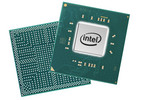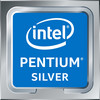Intel Celeron J4025 vs Intel Pentium Silver N5030 vs Intel Celeron N4120
Intel Celeron J4025
► remove from comparison
The Intel Celeron J4025 is an energy-efficient, dual-core processor (SoC) of the Gemini Lake Refresh product family; as such, it is designed for use in mini-PCs of the most affordable flavor. The Celeron was launched in Q4 2019. Its CPU cores run at 2 GHz to 2.9 GHz (single core boost). Other key specs include a DDR4/LPDDR4 memory controller (up to 2,400 MHz and up to 8 GB, with independent reports claiming as much as 32 GB will work just fine) and the integrated UHD Graphics 600 graphics adapter.
Architecture
Just like Apollo Lake family products, the ever-popular N3350 included, Celeron J4025 is manufactured by Intel on a 14 nm process. What makes these newer Celerons different are the slightly improved processor cores with double the L2 cache and also, somewhat counterintuitively, their smaller chip area.
The Goldmont Plus microarchitecture is familiar to us from Gemini Lake processors like the N4000. A moderately large 4 MB L2 cache features prominently on the rather short list of Goldmont Plus' strong sides, allowing for a marginal increase in performance-per-MHz figures compared to Goldmont. Still, Gemini Lake Refresh processors are a clear step-down from the Core i3/i5/i7/i9 series processors, both in performance and in features.
J4025 has six PCI-Express 2.0 lanes at its disposal. While very few J4025-based SBCs, nettops and laptops feature an NVMe M.2 slot, you can use an NVMe SSD as a boot drive with this processor (read/write rates will be limited to 2 GB/s though). Furthermore, partial Wi-Fi 5 support is built into the CPU. The Celeron also supports up to eight USB 3.0 ports and two SATA III storage devices.
Please note this is not a user-replaceable CPU. They solder it straight on to the motherboard for good (FCBGA1090 socket interface).
Performance
The Celeron J4025 is positioned in the lower entry level and only slightly faster than the mobile Celeron N4020. Therefore, it is best suited for basic tasks like word processing and web browsing with just two or three tabs open.
Graphics
The UHD Graphics 600 is based on Intel's Generation 9 architecture, much like HD Graphics 520 or UHD Graphics 615 or so many other widespread Intel iGPUs.
Just like HD Graphics 500, the UHD Graphics 600 supports DX 12 and has 12 EUs clocked at up to 650 MHz. The Iris Plus G7 iGPU that certain 10th Gen Ice Lake processors have packs 64 EUs, for reference. As a low-end solution, UHD Graphics 600 will let you play some seriously old titles, but that's about it.
Perhaps more importantly, this graphics solution will let you run up to 3 monitors with resolutions as high as 4096x2160@60. Furthermore, it will have no trouble HW-decoding AVC, HEVC and VP9 videos. The newer AV1 codec will be decoded via software, with the limited CPU horsepower imposing a hard limit on the video resolution that can be played back without stuttering. 1080p60 YouTube videos are out of reach while 720p25 videos run fine, to give you an example.
Power Consumption
As a J-series CPU, the TDP is rated at 10 Watts and therefore 4 W higher than the mobile N4020.
Intel Pentium Silver N5030
► remove from comparison
The Intel Pentium Silver N5030 is a quad-core SoC primarily for inexpensive notebooks and was announced late 2019. It runs at 1.1-3.1 GHz (Single Core Burst) and is based on the Gemini Lake platform. The 5030 is the refresh of the older Pentium 5000 and offers a 400 MHz higher Boost clock. Similar to the Apollo Lake predecessor, the chip is manufactured in a 14 nm process with FinFETs but offers slightly improved processor cores, double the amount of L2 cache, a smaller package, a better GPU architecture and a partly integrated WiFi support. Besides four CPU cores, the chip also includes a DirectX 12 capable GPU as well as a DDR4/LPDDR4 memory controller (dual-channel, up to 2400 MHz). The SoC is not replaceable as it is directly soldered to the mainboard.
Architecture
The processor architecture is still called Goldmont Plus. Compared to the older Goldmont cores in Apollo Lake, they feature an increased level 2 cache (to 4 MB). That means the per-clock-performance should be a bit better, but not near the Core CPUs like Kaby Lake Y.
Performance
The average N5030 in our database proves unable to beat the AMD 3020e, an entry-level dual-core CPU of similar power efficiency, in multi-thread performance, rendering the Pentium a poor option for anything but the most basic day-to-day activities, as of late 2022.
GPU Performance
The UHD Graphics 605 (Gemini Lake) is based on Intel's Gen9 architecture, which supports DirectX 12 and is also used for the Kaby Lake / Skylake / Apollo Lake graphics adapters (like HD Graphics 520). Equipped with 18 EUs and a clock of up to 750 MHz, the performance should be roughly on par with the older HD Graphics 5300 and HD Graphics 505 (Apollo Lake).
The chip also includes an advanced video engine with hardware support for the playback of VP9 and H.265 material (8-bit color-depth).
Power consumption
Like most N-class Intel chips, the Pentium has a default TDP, also known as the long-term power limit, of 6 W. This is low and thus good enough for passively cooled tablets, laptops, mini-PCs and handhelds.
The Intel Pentium N5030 is built with one of the old 14 nm Intel processes making for poor, as of early 2023, energy efficiency.
Intel Celeron N4120
► remove from comparison
The Intel Celeron N4120 is a quad-core SoC primarily for inexpensive notebooks and was announced late 2019. It runs at 1.1-2.6 GHz (Single Core Burst) and is based on the Gemini Lake platform. Compared to the predecessor, the Celeron N4100, the refresh offers a 200 MHz higher Boost clock. Similar to the Apollo Lake predecessors, the chip is manufactured in a 14 nm process with FinFETs but offers slightly improved processor cores, double the amount of L2 cache, a smaller package, a new generation of monitor outputs (Gen 10) and a partly integrated WiFi chip. Besides four CPU cores, the chip also includes a DirectX 12 capable GPU as well as a DDR4/LPDDR4 memory controller (dual-channel, up to 2400 MHz). The SoC is not replaceable as it is directly soldered to the mainboard.
Architecture
The processor architecture ist still called Goldmont Plus. Compared to the older Goldmont cores in Apollo Lake, they feature an increased level 2 cache (to 4 MB). That means the per-clock-performance should be a bit better, but not near the Core CPUs like Kaby Lake Y.
Performance
The average N4120 in our database is not much faster than AMD's Zen-based, affordable Athlon Silver 3050e, as far as multi-thread benchmark scores are concerned, with the Intel Celeron 6305 and the Core i5-7Y54 found close nearby as well. It's a very basic CPU that we're talking about here. While it does have four cores, these are some seriously slow cores, dashing hopes of anybody looking to get a Core i3-like performance for cheap.
GPU Performance
The UHD Graphics 600 (Gemini Lake) is based on Intel's Gen9 architecture, which supports DirectX 12 and is also used for the Kaby Lake / Skylake / Apollo Lake graphics adapters (like HD Graphics 520). Equipped with 12 EUs and a clock of up to 700 MHz, the performance should be roughly on par with the older HD Graphics 500 (Apollo Lake).
The chip also includes an advanced video engine with hardware support for the playback of VP9 and H.265 material (8-bit color-depth).
Power Consumption
Just like most other N-class Intel processors, Celeron N4120 has a default TDP of 6 W (also known as PL1), making it a good option for passively cooled laptops, tablets, mini-PCs. It's manufactured on a very old (as of late 2022) 14 nm process, though, making for poor energy efficiency.
| Model | Intel Celeron J4025 | Intel Pentium Silver N5030 | Intel Celeron N4120 | ||||||||||||||||||||||||||||||||||||||||||||||||||||||||||||||||||||||||
| Codename | Gemini Lake Refresh | Gemini Lake Refresh | Gemini Lake Refresh | ||||||||||||||||||||||||||||||||||||||||||||||||||||||||||||||||||||||||
| Series | Intel Gemini Lake | Intel Gemini Lake | Intel Gemini Lake | ||||||||||||||||||||||||||||||||||||||||||||||||||||||||||||||||||||||||
| Series: Gemini Lake Gemini Lake Refresh |
|
|
| ||||||||||||||||||||||||||||||||||||||||||||||||||||||||||||||||||||||||
| Clock | 2000 - 2900 MHz | 1100 - 3100 MHz | 1100 - 2600 MHz | ||||||||||||||||||||||||||||||||||||||||||||||||||||||||||||||||||||||||
| L2 Cache | 4 MB | 4 MB | 4 MB | ||||||||||||||||||||||||||||||||||||||||||||||||||||||||||||||||||||||||
| Cores / Threads | 2 / 2 | 4 / 4 | 4 / 4 | ||||||||||||||||||||||||||||||||||||||||||||||||||||||||||||||||||||||||
| TDP | 10 Watt | 6 Watt | 6 Watt | ||||||||||||||||||||||||||||||||||||||||||||||||||||||||||||||||||||||||
| Technology | 14 nm | 14 nm | 14 nm | ||||||||||||||||||||||||||||||||||||||||||||||||||||||||||||||||||||||||
| max. Temp. | 105 °C | 105 °C | 105 °C | ||||||||||||||||||||||||||||||||||||||||||||||||||||||||||||||||||||||||
| Socket | FCBGA1090 | BGA1090 | BGA1090 | ||||||||||||||||||||||||||||||||||||||||||||||||||||||||||||||||||||||||
| Features | Intel UHD Graphics 600 (12 EUs, 250 - 700 MHz), Quick Sync, AES-NI, max. 8 GB Dual-Channel DDR4/LPDDR4-2400 | DDR4-2400/LPDDR4-2400 RAM, PCIe 2, MMX, SSE, SSE2, SSE3, SSSE3, SSE4.1, SSE4.2, VMX, SMEP, SMAP, MPX, EIST, TM1, TM2, Turbo, AES-NI, RDRAND, RDSEED, SHA, SGX | DDR4-2400/LPDDR4-2400 RAM, PCIe 2, MMX, SSE, SSE2, SSE3, SSSE3, SSE4.1, SSE4.2, VMX, SMEP, SMAP, MPX, EIST, TM1, TM2, Turbo, AES-NI, RDRAND, RDSEED, SHA, SGX | ||||||||||||||||||||||||||||||||||||||||||||||||||||||||||||||||||||||||
| iGPU | Intel UHD Graphics 600 (250 - 700 MHz) | Intel UHD Graphics 605 (200 - 750 MHz) | Intel UHD Graphics 600 (200 - 700 MHz) | ||||||||||||||||||||||||||||||||||||||||||||||||||||||||||||||||||||||||
| Architecture | x86 | x86 | x86 | ||||||||||||||||||||||||||||||||||||||||||||||||||||||||||||||||||||||||
| Announced | |||||||||||||||||||||||||||||||||||||||||||||||||||||||||||||||||||||||||||
| Manufacturer | ark.intel.com | ark.intel.com | ark.intel.com |
Benchmarks
Average Benchmarks Intel Celeron J4025 → 100% n=33
Average Benchmarks Intel Pentium Silver N5030 → 116% n=33
Average Benchmarks Intel Celeron N4120 → 115% n=33
* Smaller numbers mean a higher performance
1 This benchmark is not used for the average calculation













